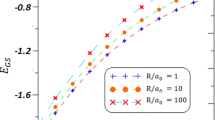Abstract
Spin-pseudo-spin intra-particle entanglement of a graphene sheet in the presence of Rashba and Hubbard interactions has been investigated. Hubbard interaction is given by the mean-field approach where we have employed the realistic value of the Hubbard interaction strength of graphene, which has been provided by theoretical computations previously performed in this field. Results show that the Hubbard interaction with its realistic strength removes spin and pseudo-spin entanglement at one of the valleys, whereas this significantly enhances the spin and pseudospin entanglement at the other valley. Accordingly, spin and pseudospin entanglement appears to be non-symmetric between these two valleys.


Similar content being viewed by others
Data Availibility Statement
The data and computational codes that support the findings of this study are available on request from the corresponding author.
Change history
15 April 2024
A Correction to this paper has been published: https://doi.org/10.1140/epjp/s13360-024-05116-z
References
I. Žutić, J. Fabian, S.D. Sarma, Spintronics: fundamentals and applications. Rev. Mod. Phys. 76(2), 323 (2004). https://doi.org/10.1103/RevModPhys.76.323
S. Wolf, D. Awschalom, R. Buhrman, J. Daughton, S. Von Molnar, M. Roukes, A.Y. Chtchelkanova, D. Treger, Spintronics: a spin-based electronics vision for the future. Science 294(5546), 1488–1495 (2001). https://doi.org/10.1126/science.1065389
S. Murakami, N. Nagaosa, S.-C. Zhang, Dissipationless quantum spin current at room temperature. Science 301(5638), 1348–1351 (2003). https://doi.org/10.1126/science.1087128
T. Farajollahpour, S. Khamouei, S.S. Shateri, A. Phirouznia, Anisotropic friedel oscillations in graphene-like materials: The dirac point approximation in wave-number dependent quantities revisited. Sci. Rep. 8(1), 1–14 (2018). https://doi.org/10.1038/s41598-018-19730-2
N. Shahabi, A. Phirouznia, Normal electric field enhanced light-induced polarizations and magnetic detection of valley polarization in silicene. Sci. Rep. 10(1), 1–11 (2020). https://doi.org/10.1038/s41598-020-73138-5
R. Baghran, M. Tehranchi, A. Phirouznia, Magnetic generation of normal pseudo-spin polarization in disordered graphene. Sci. Rep. 11(1), 1–8 (2021). https://doi.org/10.1038/s41598-021-94218-0
D. Elias, R. Gorbachev, A. Mayorov, S. Morozov, A. Zhukov, P. Blake, L. Ponomarenko, I. Grigorieva, K. Novoselov, F. Guinea, A. Geim, Dirac cones reshaped by interaction effects in suspended graphene. Nat. Phys. 7, 235431 (2011). https://doi.org/10.1038/nphys2049
D. Pesin, A.H. MacDonald, Spintronics and pseudo-spintronics in graphene and topological insulators. Nat. Mater. 11(5), 409–416 (2012). https://doi.org/10.1038/nmat3305
D. Huertas-Hernando, F. Guinea, A. Brataas, Spin-orbit coupling in curved graphene, fullerenes, nanotubes, and nanotube caps. Phys. Rev. B 74, 155426 (2006). https://doi.org/10.1103/PhysRevB.74.155426
H. Min, J.E. Hill, N.A. Sinitsyn, B.R. Sahu, L. Kleinman, A.H. MacDonald, Intrinsic and Rashba spin-orbit interactions in graphene sheets. Phys. Rev. B 74, 165310 (2006). https://doi.org/10.1103/PhysRevB.74.165310
Y. Yao, F. Ye, X.-L. Qi, S.-C. Zhang, Z. Fang, Spin-orbit gap of graphene: first-principles calculations. Phys. Rev. B 75, 041401 (2007). https://doi.org/10.1103/PhysRevB.75.041401
M. Gmitra, S. Konschuh, C. Ertler, C. Ambrosch-Draxl, J. Fabian, Band-structure topologies of graphene: spin-orbit coupling effects from first principles. Phys. Rev. B 80, 235431 (2009). https://doi.org/10.1103/PhysRevB.80.235431
M. Trushin, J. Schliemann, Pseudo-spin in optical and transport properties of graphene. Phys. Rev. Lett. 107, 156801 (2011). https://doi.org/10.1103/PhysRevLett.107.156801
F. Souza, G.M.A. Almeida, M.L. Lyra, M.S.S. Pereira, Interplay between charge and spin thermal entanglement in Hubbard dimers. Phys. Rev. A 102, 032421 (2020). https://doi.org/10.1103/PhysRevA.102.032421
J.P. Coe, V.V. França, I. D’Amico, Hubbard model as an approximation to the entanglement in nanostructures. Phys. Rev. A 81, 052321 (2010). https://doi.org/10.1103/PhysRevA.81.052321
S.-J. Gu, S.-S. Deng, Y.-Q. Li, H.-Q. Lin, Entanglement and quantum phase transition in the extended Hubbard model. Phys. Rev. Lett. 93, 086402 (2004). https://doi.org/10.1103/PhysRevLett.93.086402
H. Feldner, Z.Y. Meng, A. Honecker, D. Cabra, S. Wessel, F.F. Assaad, Magnetism of finite graphene samples: mean-field theory compared with exact diagonalization and quantum monte carlo simulations. Phys. Rev. B 81, 115416 (2010). https://doi.org/10.1103/PhysRevB.81.115416
B. Valenzuela, M.A.H. Vozmediano, Pomeranchuk instability in doped graphene. New J. Phys. 10(11), 113009 (2008). https://doi.org/10.1088/1367-2630/10/11/113009
W.K. Wootters, Entanglement of formation of an arbitrary state of two qubits. Phys. Rev. Lett. 80, 2245–2248 (1998). https://doi.org/10.1103/PhysRevLett.80.2245
T.O. Wehling, E. ŞaşıOğlu, C. Friedrich, A.I. Lichtenstein, M.I. Katsnelson, S. Blügel, Strength of effective coulomb interactions in graphene and graphite. Phys. Rev. Lett. 106, 236805 (2011). https://doi.org/10.1103/PhysRevLett.106.236805
B.G. Moraes, W. de Aron, Cummings, Stephan Roche, emergence of intraparticle entanglement and time-varying violation of Bell’s inequality in Dirac matter. Phys. Rev. B 102, 041403 (2020). https://doi.org/10.1103/PhysRevB.102.041403
B.G. Moraes Araújo, A. Acín, D. Cavalcanti Santos, S.J.L. Roche, J. Calsamiglia Costa, Quantum information in lattices. Universitat Autnoma de Barcelona. Programa de Doctorat en Fsica (2022) https://ddd.uab.cat/record/267056
Author information
Authors and Affiliations
Contributions
All authors contributed to the present study. Computation, and results analysis were performed by AP, ShA and EF. The first draft of the manuscript was written by ShA and AP. All authors read and approved the final manuscript.
Corresponding author
Rights and permissions
Springer Nature or its licensor (e.g. a society or other partner) holds exclusive rights to this article under a publishing agreement with the author(s) or other rightsholder(s); author self-archiving of the accepted manuscript version of this article is solely governed by the terms of such publishing agreement and applicable law.
About this article
Cite this article
Ahsani, S., Faizi, E. & Phirouznia, A. Hubbard interaction induced non-symmetric spin and pseudo-spin entanglement at different valleys of graphene. Eur. Phys. J. Plus 139, 178 (2024). https://doi.org/10.1140/epjp/s13360-024-04985-8
Received:
Accepted:
Published:
DOI: https://doi.org/10.1140/epjp/s13360-024-04985-8




